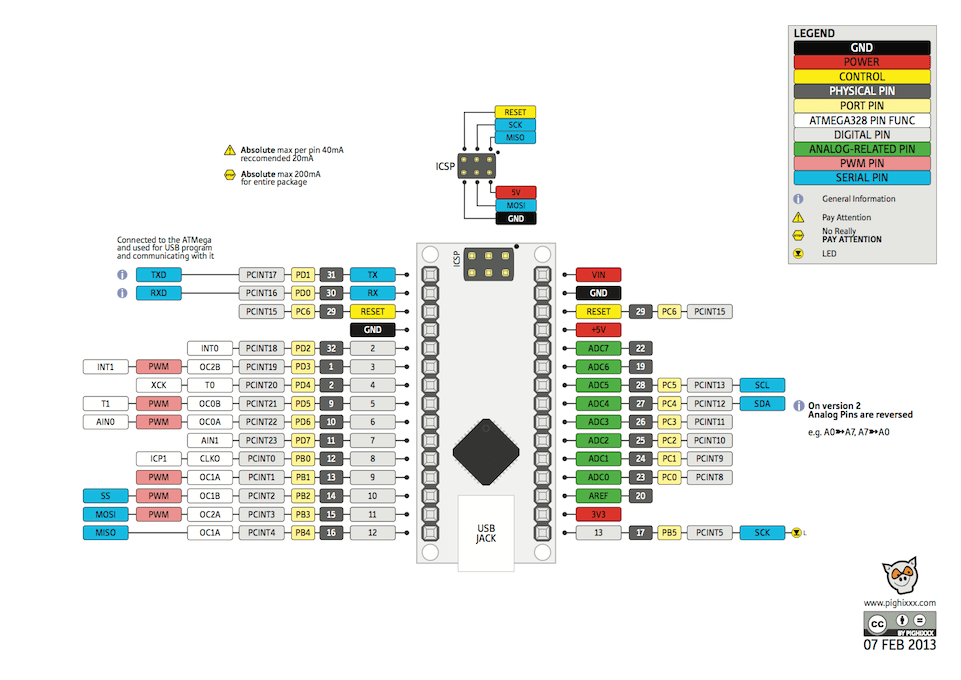Size daha iyi hizmet sunabilmek için çerezleri kullanıyoruz.
Web sitemizde gezinme deneyiminizi geliştirmek, size kişiselleştirilmiş içerik ve hedefli reklamlar göstermek, web sitesi trafiğimizi analiz etmek ve ziyaretçilerimizin nereden geldiğini anlamak için çerezleri ve diğer izleme teknolojilerini kullanıyoruz.
Out Of Stock
Notify me when its in stockNano 328 Development Board Compatible with Arduino (Wih USB Cable)
Nano 328 Development Board Compatible with Arduino (Wih USB Cable) Product content:
Nano is a microcontroller board based on Atmega328. There are 16 digital I/O pins (6 of them are PWM out), 8 analog input pins, a 16 MHz crystal oscilator, an USB socket, a power socket, an ICSP connector and reset button on the board. There are the all essential parts on the board for microcontroller operations. The board can easily be connected to the computer via usb or can be used with an external adapter of battery.
Nano has an FTDI FT232 usb - serial chip for programming and communicaiton with computer via usb.
Nano 328 Development Board Compatible with Arduino (Wih USB Cable) Features:
Power:
Nano can be supplied via usb or an external voltage source. External voltage source would be an AC - DC adapter or a battery. 7-20 V power supply is recommended. Moreover, the connectors of the power socket on the board, Vin and GND pins are short circuited in beckend. The battery can be connected to the board via GND and Vin pins.
It is not necessary to be connected to usb port during whole the operation. The board can be energized with only an adapter or a battery too, by this way, the board can work independently from the computer.
6 - 20 V can be used as an external supply but these are the limits for Uno. Recommanded voltage supply for this board is between 7 - 20 V. Becouse the regulator on the board might not work stabile for the voltages below 7V. Likewise, it can be over - warmed for the voltages above 12 V.
Operating voltage of the Nano's microcontroller is 5 V. If the voltage supplies the board via Vin pin or the power socket on 7 V to 12 V, then this voltage is regulated and distributed to the board by the regulator.
Power pins are like that:
Memory:
Atmega328 has an 32 kB flash memory (0.5 kB of this is used by the bootloader), 2 kB SRAM and 1 kB EEPROM.
Input and Output:
All of the 14 digital pins on the Nano board can be configured both as an input or an output. There are 8 analog input pins on the board too. All of these analog pins can be configured as digital input or output. In total there are 22 digital input - output pins on the board. Logic level of these pins are all 5 V. All of these pins are able to provide an output current up to 40 mA. Additionally, some of these pins have diffrent features too, listed below:
Communication:
There are several options for Nano to communicate with another arduino or microcontroller. Atmega328 provides UART TTL (5V) Serial communication via its 0 (RX) and 1 (TX) pins. FT232 connects to a computer by opening a virtual serial COM port and allows the serial communication. Arduino IDE, thanks to its serial monitor find in the computer software, provides to send and recieve text based information. RX and TX leds on the board blink while the board is communicating via USB.
There is a phsycally serial port on the Nano board but this number can be increased with the SoftwareSerial library as software.
Atmega328 provides I2C and SPI ports too. Wire library if to use I2C and SPI library is for SPI communication.
Programming:
Nano board can be programmed with the Arduino computer software (Arduino IDE). You can start programming by choosing Arduino Nano under tools > board menu on the Arduino IDE. For details you may see the referance and the basic functions page. Atmega328 on the Arduino Nano board comes together with a specific software installed, named bootloader. Thanks to this it is not needed to use an external programming device to program Arduino Nano. Communication is supplied by and original STK500 protocol.
The board can be programmed by using ICSP headers via ISP programmer instead of bootloader software (Referance).
Usb high current protection:
Nano board has restarable high current protectors. Even if your computer has its own protectors for its USB ports, the protectors on the board is adjusted to reject more than 500mA. If this amount of current is reached, protectors will keep open - circuit the connection untill the short - circuit disappears.
